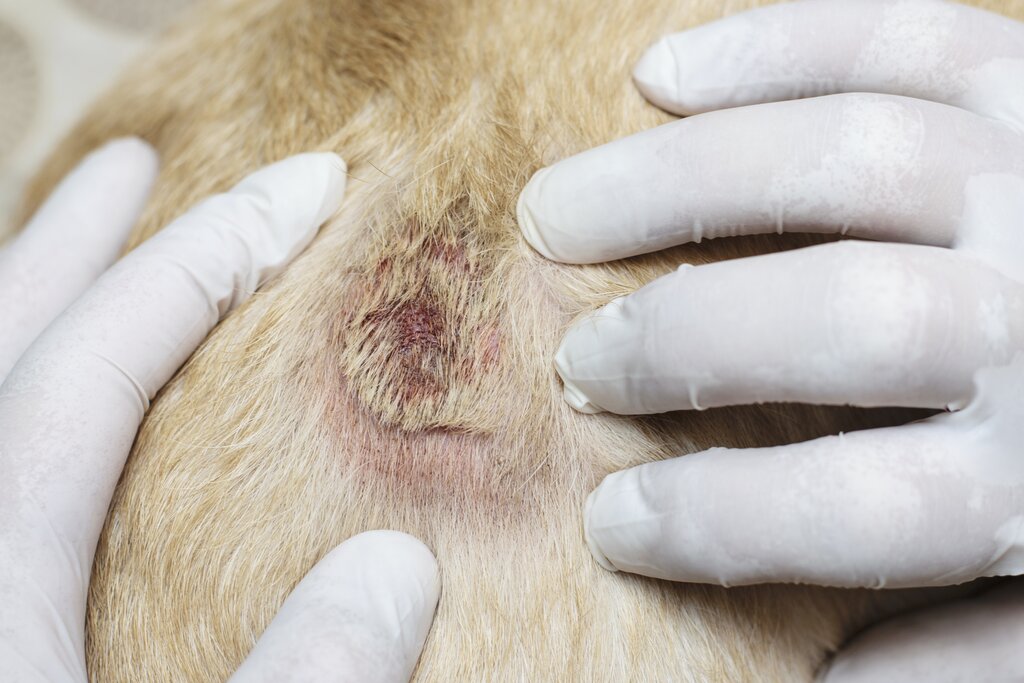Last Updated: 03/06/2025
Hot Spots on Dogs: Causes Treatment and Prevention
Does your dog get hot spots? Take a read through the common causes and strategies.
Author: Dr Angie Armstrong BVSc
Reading Time: 24 minutes - medium read
If you have a dog with a long coat and live in a warm climate you no doubt have come across dreaded hot spots! They can almost grow in front of your eyes and can be quite itchy and irritating for your dog! Read all about what this skin irritation actually is and some tips for treatment, prevention and management of it.
What are hot spots?

Also known as pyotraumatic dermatitis, hot spots are skin lesions or wounds which are commonly seen in dogs and rarely in cats. The skin irritation is caused by self-induced trauma, which basically means the dog scratches, licks, rubs or chews the skin, because of them trying to alleviate an itch or painful irritation. This underlying itch or irritatation can be caused by a number of different factors of which the most common are listed below. This trauma to the skin results in inflammation and secondary bacterial infection as the normal skin bacteria are overrun due to damage to the surface of the skin.
Hot spots can arise quickly, and they often can look worse than what they are. When they are fresh the wounds can look red and weepy and sometimes bloody and infected, and then with healing they progress to dry and scabby. If there is actual infection present in the skin, it is usually quite superficial, but the infection can progress to deeper pyoderma (pus in the skin) or folliculitis (inflammation of the hair follicles).
Hot spots generally have quite clear margins defining them so often appear as solitary lesions and are quite easily identifiable from normal skin. They can be tender and painful for the dog and can enlarge rapidly so early diagnosis is important.
Dogs with dense coats are more likely to get hot spots as these coats may trap moisture. Therefore they may be more commonly seen in the following breeds: Golden Retrievers, Labrador Retrievers, Rottweilers and German Shepherds. Hot spots are more common during hot and humid weather (when heat and humidity encourage bacterial growth) but they can still occur all year-round.
Causes of Hot Spots
Common causes of hot spot on dogs include:
- Parasites (for example fleas and mites)
- Ear infections
- Contact allergies
- Inhalent allergies
- Matted hair or coat
- Skin irritation (such as from clipper rash)
- Stress or boredom
- Anal sac disease
- Food allergies
- Immune-mediated skin diseases
For more information about skin conditions in dogs, take a read through our articles on:
Diagnosis of Hot Spots

Diagnosis is based on presentation and visual examination of the skin lesion, but determining the cause can be a little trickier. History is also important, such as a recent grooming event (which may have caused clipper rash). As mentioned, hot spots are well-defined areas of redness, swelling and wetness and they are commonly seen on the head, limbs and hips. The affected area of skin is usually moist and may even be discharging with some pus which can lead to the surrounding hair and coat being matted and crusted. The location of the hot spot can help identify the cause or at least give clues. For instance, a hot spot on the jaw and neck could indicate an ear infection, one on the rump could indicate anal gland impaction or infection and over the hip could indicate a flea infestation.
Tests may be performed by your vet to help diagnose the possible cause.
Tests used to diagnose hot spots
- Visual inspection for parasites such as fleas
- Smears of the wound to look at cells under the microscope
- Skin scrapes to diagnose parasites like mites
- Skin culture and/or biopsy
- Response to treatment for allergies
- Intradermal skin allergy testing at the veterinary dermatologist
What are the treatment options for hot spots?

The first step for treatment is to clip or shave the affected area. Hot spots are frequently painful and large, subsequently sedation or an anaesthetic by your vet may be required before clipping is attempted. Clipping the area will reveal how large the wound is, and will allow air in to help with healing, as hair holds moisture in. Your veterinarian may need to culture the affected skin to identify the bacteria causing the infection and help select the most appropriate antibiotic. Additionally vets may perform other tests to help determine the cause and best treatment plan.
The hot spot is then cleaned, disinfected and dried. It can be disinfected with an antiseptic solution such as chlorhexidine, or a medicated shampoo. Further treatment will depend on the size of the hot spot, location, and the cause. Often antibiotics are required (either in topical, oral, or injectable form) and some medication to control the inflammation and itch such as a steroid (again in topical, oral or injectable form).
Small hot spots can sometimes be treated at home. Although caution must be taken as frequently the wounds are painful, subsequently dogs often don't like them assessed,and therefore a visit to the vet is often recommended and required. Some human topical products can also be toxic to pets when licked so if you are unsure, always ask your vet what they recommend. Furthermore, hot spots often don't resolve without treatment so best not to wait and make an appointment with your vet as soon as you notice them!
Further treatment will depend on the inciting cause; such as ear infections may require ear drops, anal gland abscesses may require surgery and medications, and parasites will require anti-parasitic treatment.
Summary of treatment steps
- Clip the area to remove hair and matting
- Clean with an antiseptic solution like chlorhexidine
- Let the area dry
- Use prescribed medication such as antibiotics (to treat the infection) and steroids (to control the inflammation and itch)
- Apply an Elizabethan collar to stop further scratching, licking and trauma being caused to the skin
- Use medicated wipes, shampoos or lotions prescribed and instructed by your vet
In many cases, once the hot spot has been clipped, cleaned, and medication started, it should resolve quite quickly within a few days to a week.
Hot Spot treatment aids
How to prevent hot spots
Preventing hot spots is not always straightforward! It is most successful when the underlying cause can be identified, treated, and thus prevented, which is often easier said than done. Here are some tips that may help!
Tips for preventing hot spots:
- Make sure you dog is up to date with parasite prevention
- Get on top of any skin allergies as quickly as possible
- Use an elizabethan collar if you notice your dog scratching their skin
- Routine grooming and bathing can help prevent matting especially in breeds prone to getting hot spots
- Skin supplements and diet to help nourish and strenghten the skin barrier
- Use the correct shampoo and conditioner for your dog's skin, such as a sensitive one, nourishing one, or medicated one with antibacterial properties
- Dry your dog's coat well after swimming or bathing to prevent excessive moisture remaining on the skin
- Get your dog's anal glands expressed if the are scooting (rubbing their bottom on the ground)
- Get on top of ear infections quickly (this may be with regular cleaning, medication and keeping them dry when swimming and bathing)
- Speak to your vet about whether your dog may benefit from a skin support diet.
Take a read through our article to decide if your dog could benefit from a diet best suited for skin allergies
References
Veterinary Information Network (VIN), Hot Spots in Dogs and Cats, https://veterinarypartner.vin.com/default.aspx?pid=19239&catId=102903&id=4952729, accessed 3/2/23
Veterinary Information Network (VIN), Hot Spots (Pyotraumatic Dermatitis) in Dogs and Cats, https://veterinarypartner.vin.com/default.aspx?pid=19239&id=4952981, accessed 3/2/23
Further Reading
Want to read more? Check out our other articles:
Yeast infections and allergies in dogs
How to stop my dog from licking their paws
Flea, tick and worm prevention for dogs
History
Our experts continually monitor the health and wellness space and we update our articles when new information becomes available.
Apr 23 2024
Written by Dr Angie Armstrong BVScDr Angie Armstrong BVSc
BVSc
Dr Angie Armstrong graduated from the University of Queensland in 2008 with a Bachelor of Veterinary Science and worked for a number of years in small animal clinics across South East Queensland.

